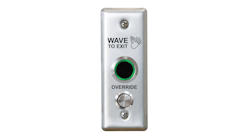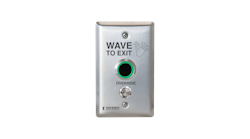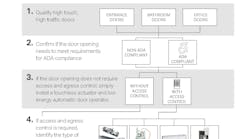The interest in hands-free door solutions got a boost from the COVID era, where fears of cross-contamination triggered actions and legislation to mitigate the threat posed by handling door hardware. However, the appeal of hands-free control of openings is not new, and there have been solutions available for decades to allow control and minimize hand contact with doors and other items.
“Electric Eyes” were used to create invisible barriers to count traffic, actuate gate and door operators, or establish safety zones to avoid injuries or damage from doors or gates hitting persons, vehicles, or merchandise. Electric eyes involved a light source, a target and sometimes reflectors so the beam could extend around corners. The introduction of LEDs and solid-state circuitry extended the life span of these devices to where they continue to be a solution for many situations.
Pressure Mats are used to detect the weight of a pedestrian in a doorway for door control and security applications. They used metal ribbons or pneumatic tubing to actuate switches which in turn signaled devices to the presence of a possible victim.
Motion Sensors revolutionized the security and door control industries since they are single-ended (not requiring a target which limited their range. There were a variety of technologies used for these including ultra-sonic and later on infrared, as well as devices which used a combination of these technologies, or special licensed processes which also involved signal processing to achieve the desired results. Uses include REX sensors for egress, approach sensors presence detectors, devices used for alarm security interior protection, and even smoke detection.
One of the shortcomings of infrared motion detectors is that they may fail to detect individuals if smoke enters the field of view. This weakness is why motion sensors are not permitted to be the only method of controlling doors for egress. At least one secondary method is required, in addition to immediate removal of power to the locks in the event of a fire alarm.
When smoke fills an area, obscuration occurs. That is what typical smoke detectord sense, obscuration within the target chamber in the smoke detector by particles of the products of combustion. Optical beam smoke detectors use obscuration to detect smoke over a much larger area.
If you are a security pro who (like me) has accumulated a fair amount of windshield time plying the security trade, I’ll bet you are pounding the table or bursting out expletives as you read this as you flash back to past experiences you’ve had with each of these technologies.
I know I have had many exciting experiences supplying successful and innovative solutions to clients over the years, but I also had some real career-changing disasters and took huge losses with some of these bleeding-edge innovations; then immediately thanking God for refinements and renovations which now provides us with the relatively miraculous tools and devices we have available today.
These days, with quality-controlled manufacturing and operational benchmarking such as UL and ANSI, and beta testing, these types of disasters are a thing of the past. We all made it through to be here together, and the future of security technology is bright and very promising.
Not all touchless openings involve an automatic door opener. If access is restricted, some sort of credential must be used, be it a smartphone or badge or other wearable notifying the door to lock or unlock. Some doors require access control to open from one side and free egress from the other. If access or egress is not restricted, there must be some mechanism that persons trigger to prompt the door to open. Thus, in recent years we’ve seen an explosion of high-tech and low-tech devices. Here is a brief sampling of what’s on the menu these days.
Alarm Controls NTB No-Touch Sensor
Alarm Controls’ battery-powered NTB No Touch request-to-exit buttons are a direct replacement for traditional “request to exit” pushbuttons. They use infrared sensors to reliably allow safe egress or to activate a device with a simple hand presentation. Active infrared sensors work with ‘radar’ technology and they both emit and receive infrared radiation. This radiation hits the objects nearby and bounces back to the receiver of the device. Through this technology, the sensor can not only detect movement in an environment but also how far the object is from the device.
Many “knowing act controllers” use with door operators are battery operated which makes installation simpler, (and more or less guarantees follow-up service calls.)
This device offers a sophisticated no-touch function which appeals to those who are concerned about physically contacting things because of health concerns and environments where the convenience of no-touch is attractive. It is designed to reduce the risk of contamination for sensitive applications including: bathrooms, hospitals, labs, schools and offices.
These sensors use self-contained batteries. They wire back to control the equipment. They can also use 12 24 Volt DC so you can run power wiring and provide DC power from a central location. If you do not wish to wire back, many wireless transmitter/receiver kits are available.
These request-to-exit solutions provide greater flexibility and control for sensitive applications, without the need to make costly modifications, extending touchless access and egress in an easy and affordable way. The NTB Series is a direct replacement for traditional “request to exit” push buttons and can be used to quickly upgrade They are designed to work in product configurations with and without auto operator (This can include electric strike, electrified deadlatch, exit devices with latch retraction, magnetic locks. Always check with your local AHJ.)
Standard features:
- Battery or DC powered (optional)
- Low battery LED status indicator
- Wired communication
- Stainless steel with vandal resistant face plate
- Sensor detection range up to 4" for applications that require precise activation
- Built in obstruction detection
- Field-configurable bi-color (red/green) LED status indicators
- Selectable time delay 1 to 10 seconds
- Field-configurable on/off audible tones configurable via jumper
- Plate screened "Wave To Open"
- For use with swinging and sliding door applications
Options:
- NTB-1 with single gang wall plate
- NTB-1A single gang with ADA symbol
- NTB-2 with double gang wall plate
- NTB-2A double gang with ADA symbol
- NTB-3 with narrow stile wall plate
- NTB-3A narrow stile with ADA symbol
They are available in stainless steel (standard), black (BK), and Duranodic Dark Bronze (DURO) finishes.
They are CE Certified, UL294 Listed and RoHS Certified,
More info: https://www.alarmcontrols.com/en/products/exit-devices/nts/
Securitron WSS-WSD Wave Sense Switch
The Securitron Wave Sense Switch features a new class of microwave motion sensing technology for hands-free, contactless switch activation. This touchless switch is optimal for request-to-exit - stations, activation applications or on/off switching to trigger a variety of access control devices in place of a pushplate or push button.
A Microwave sensor uses high frequency radio waves operating at 360 degrees. They work in a similar way to radar, working on changes in the reflected radio waves.
Product Features:
- Touchless activation for hands-free operation, reduces transmission of germs
- Microwave motion sensing allows for reliable, hands-free activation
- Adjustable sensing zone from 4” to 24” helps screen out incidental traffic
- FCC certified for use in general and medical environments
- Pulse mode to initiate action or toggle mode to provide on/off switch
- Mounting ring included or install in standard plastic or metal gang box
- Compatible with Securitron WBB Weather Back Box and WCC Weather Cover-Clear
- Part of a continuum of Safer2Open low-touch and touchless door hardware solutions from ASSA ABLOY
Camden No-Touch Restroom/Privacy System Kit
In addition to an extensive line of wave-to-open switches, Camden Door Controls has introduced its CX-WC17VR-PS restroom/privacy system kit which features Camden’s CM-7536VR column switches with built-in no-touch sensor activation.
These column switches are ADA-compliant and designed to meet building code requirements for ‘high/low’ activation switches. The addition of hands-free activation eliminates the spread of germs. Column switches with no-touch sensors also feature a red/green LED to indicate door lock status, eliminating the need for separate ‘occupied’ and ‘locked’ annunciators.
The CX-WC17VR-PS restroom/privacy system kits are a complete solution that includes ‘Push/Wave to Open’ and ‘Push/Wave to Lock’ activation switches, a 2 Amp power supply and controller in a small metal cabinet, ‘universal’ electric strike, and door contacts.
More info: www.camdencontrols.com/products/WC_Restroom_Control_Kits
SureWave and ValueWave
Camden CM-221 Series ValueWave switches offer the convenience of hands-free activation and provide industry-leading dependability and performance. Aimed at indoor or outdoor use as part of an automatic door or access control system, ValueWave no-touch switches are easy to install and designed for trouble-free service in high-traffic applications. CM-221 Series switches are available in a range of models, with narrow, single- and double-gang stainless steel faceplates and a selection of laser-etched faceplate graphics. A manual override to the ValueWave single-gang, no-touch switch is designed to provide assurance that a request-to-exit switch will open a door, even if the switch sensor fails to operate.
SureWave CM-336 Series (battery-powered wireless switches) and CM-333 Series (battery-powered relay output touchless switches) now can be surface-mounted by using Camden’s new CM-23DSER narrow surface box. This mounting box features a two-piece flame- and impact-resistant ABS construction. Extra-deep narrow surface-mounting boxes can be purchased separately or as part of Camden’s SureWave CM-336 Series switch kits. These kits include two CM-336/42N narrow stainless steel switches, two CM-23DSER surface boxes and a CM-RX-90 relay receiver. The CM-336 Series of battery-operated 915-megahertz wireless switches recently joined Camden’s SureWave line of touchless switches and feature a proven Lazerpoint RF transmitter.
More info: www.camdencontrols.com
SDC 470 Series
SDC’s 470 series touchless switches use active IR sensor technology. A simple wave of the hand in front of the 470 touchless switch activates the switch to control electric locks/ strikes, magnetic locks or automatic door operators for entry or egress. 470 series touchless switches come standard with an adjustable 2”-7” activation read range.
The dual LED illuminated sensor clearly indicates status. The red LED indicates inactive status, which changes to a temporary green LED state to indicate activation. Ideal for, but not limited to, facilities that require contamination control. Touchless switches help reduce the spread of infection and disease in any application.
Models include the 474 Single Gang, 474D Double Gang and 474M Single Gang no-touch sensor with manual override.
More info: www.sdcsecurity.com
STI NoTouch Buttons
STI’s new NoTouch Infrared Switches help to eliminate the spread of germs in any public building. To exit, a person simply waves their hand in front of the device. The infrared will detect the motion and unlatch the time-adjustable door. The buttons are available in corrosion-resistant stainless steel and in cast aluminum, which allows them to take tough knocks in stride. Also, the faceplate is oversized slightly for retrofit applications to cover marks from a previous install. This durable and long-lasting button is installed within minutes on site.
NoTouch® Stainless Steel Button offers three standard models: OPEN, EXIT and the international exit symbol representing a person exiting. Custom models are also available with printing capabilities at STI’s corporate and international offices. Buttons are shipped with the red light indicating standby, and it changes to green when active. Wave a hand in front of the red illuminated button and the color turns to green indicating the door released. Option for the opposite colors, green/standby and red/ active, can be easily changed on-site.
More info: www.sti-usa.com
BEA EAGLE Family
Another major application for wireless motion sensors are those which are used for fully automatic doors such as used in retail stores. Not only do you not touch them, but you probably never even notice them. They are out of sight and out of mind, but open the doors as we enter and leave the establishments.
BEA’s EAGLE FAMILY of motion sensors is designed for the activation of automatic pedestrian doors.
The EAGLE is universally compatible with all makes and models of swinging, sliding and revolving automatic doors. The EAGLE HM has a mounting height of 10 to 16.6 feet, making it ideal for use on large-format doors in industrial environments.
Unidirectional radar increases energy efficiency by detecting approaching traffic while ignoring motion away from the door. The motion detection feature is capable of detecting traffic moving as slow as two inches per second. Immunity settings can be adjusted to reduce unwanted detections caused by rain, snow and header vibrations
More info: www.beasensors.com
.






